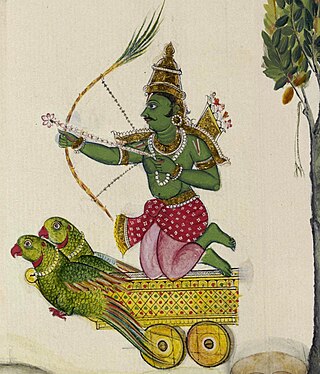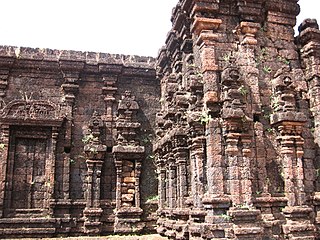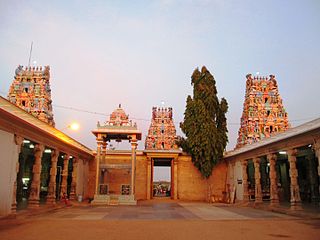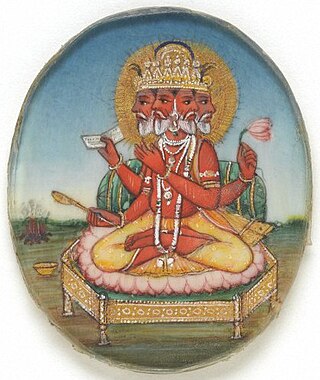
The Trimūrti is the trinity of supreme divinity in Hinduism, in which the cosmic functions of creation, preservation, and destruction are personified as a triad of deities. Typically, the designations are that of Brahma the creator, Vishnu the preserver, and Shiva the destroyer. The Om symbol of Hinduism is considered to have an allusion to Trimurti, where the A, U, and M phonemes of the word are considered to indicate creation, preservation and destruction, adding up to represent Brahman. The Tridevi is the trinity of goddess consorts for the Trimurti.

Avatar is a concept within Hinduism that in Sanskrit literally means "descent". It signifies the material appearance or incarnation of a powerful deity, or spirit on Earth. The relative verb to "alight, to make one's appearance" is sometimes used to refer to any guru or revered human being.

Harihara is the fused sattvika characterisation of Vishnu (Hari) and Shiva (Hara) from Hindu theology. Hari is the form of Vishnu, and Hara is the form of Shiva. Harihara is also known as Shankaranarayana.

Kama, also known as Kamadeva and Manmatha, is the Hindu god of erotic love, desire, and pleasure, often portrayed alongside his consort and female counterpart, Rati. He is depicted as a handsome young man decked with ornaments and flowers, armed with a bow of sugarcane and shooting arrows of flowers.

Guruvayurappan also often rendered Guruvayoorappan, is a form of Vishnu worshipped mainly in Kerala. He is the presiding deity of the Guruvayur temple, who is worshipped as Krishna in his child form, also known as Guruvayur Unnikkannan. Even though the deity is that of chaturbahu Vishnu, the sankalpam (concept) of the people is that the deity is the infant form of Krishna. The deity represents the purna rupa revealed by baby Krishna to his parents Vasudeva and Devaki immediately after his advent in Kamsa's jail. Hence, the deity represents both Krishna and Vishnu. The temple is located in the town of Guruvayur, Thrissur, Kerala, India, which is named after the deity itself.

Ishana, is a Hindu god and the dikapala of the northeast direction. He is often considered to be one of the forms of the god Shiva, and is also often counted among the eleven Rudras. He is venerated in Hinduism, some schools of Buddhism and Jainism. In the Vastu Shastra, the north-eastern corner of a plot of land is referred to as "Ishana". Ishana also shares qualities with Samhara Bhairava and is therefore a part of the Ashta Bhairava.

The Rajarajeshwara temple is a Shiva temple located in Taliparamba in Kannur district of Kerala State of India. The temple is regarded as one of the existing 108 ancient Shiva Temples of ancient Kerala. It also has a prominent place amongst the numerous Shiva temples in South India. It had the tallest shikhara amongst the temples of its time. The Rajarajeshwara temple has a top of about 90 tonnes. If any problem is encountered in the other temples of South India, devotees seek a solution in this temple through a prashnam, a traditional method of astrological decision-making. The prashnam is conducted on a peedha outside the temple.

Tripurasura is a trio of asura brothers named Tarakaksha, Vidyunmāli and Kamalaksha, who were the sons of the asura Tarakasura. These three began to perform severe tapasya. They were then granted boons by Brahma to have three forts: gold, silver, and iron, which angered the Devas. Vishnu then made a new religion to make them evil, and the objective of killing the asuras was taken upon by Lord Shiva, which took three days on the battlefield, finally killing Tripurasura and destroying the three cities. This occurred on the full moon day in the Kartik month and therefore the day is celebrated as Tripurari Pournima.

Kodumudi is a panchayat town and taluk headquarters of Kodumudi taluk in Erode district at state of Tamil Nadu, India. Kodumudi has an average elevation of 144 metres (472 feet). Also Kodumudi is an tourism spot. The holy Kaveri river and Magudeswarar temple in Kodumudi attracts thousands of pilgrims daily across South India.

The Thanumalayan Temple, also called Sthanumalayan Temple is an important Hindu temple located in Suchindram in the Kanyakumari district of Tamil Nadu, India. It is one of the 108 shiva temple revered by the Kerala Hindu culture, though this temple is now in Tamil Nadu, when Kanyakumari District was merged into Tamil Nadu from Travancore. The Thanumalayan Temple is of importance to both Shaivaite and Vaishnavite sects of Hinduism, as the name Stanumalaya denotes Trimurtis; "Stanu" means Siva; "Mal" means Vishnu; and the "Ayan" means Brahma.

Anandavalleeswaram Sri Mahadevar Temple in Kollam city is one of the ancient Hindu temples in Kerala, India. Lord Siva and Goddess Anandavally are the main deities of the temple. According to folklore, sage Parashurama has installed the idol of Lord Shiva. The temple is a part of the 108 famous Shiva temples in Kerala. It is located at Anandavalleeswaram, a major neighborhood of Kollam city, that comes to the west side of Kollam Collectorate.

Brahma is a Hindu god, referred to as "the Creator" within the Trimurti, the trinity of supreme divinity that includes Vishnu and Shiva. He is associated with creation, knowledge, and the Vedas. Brahma is prominently mentioned in creation legends. In some Puranas, he created himself in a golden embryo known as the Hiranyagarbha.

Sri Vasudevapuram Temple is one of three ancient temples (Maha-Kshetram) on the Southern bank of holy river Bharathapuzha. It sits east of the other two, Maha-Shiva Temple and Brahma temple. These temples along with the famous Thirunavaya Maha-Vishnu temple across the river form the trilogy in Sanatana Dharma). Tavanur is called Muvaankara (മൂവ്വാങ്കര). Brahma, Vishnu, and Shiva are the presiding deities, so it was initially known as Muvalankara, and then Muvaankara. Vasudevapuram Tavanur is situated in the middle of a wooded area resembling that of Sabarimala.
Nandeeswarar Temple is located in Adambakkam in Chennai, Tamilnadu, India. It is close to St. Thomas Mount suburban railway station. The temple has two entrances one in the east, and another in the south. There is a tank situated outside the southern entrance, though not in use.

Panch Prayag is an expression in Hindu religious ethos, specifically used to connote the five sacred river confluences in the Garhwal Himalayas in the state of Uttarakhand, India. The five prayags - prayaga meaning "place of confluence of rivers" in Sanskrit - also termed as "Prayag pentad" are Vishnuprayag, Nandaprayag, Karnaprayag, Rudraprayag and Devprayag, in the descending flow sequence of their occurrence.

Thiruvarkala Sri Janardana Swami Maha Temple is a 2000+ year-old temple situated in Janardhanapuram in the municipality of Varkala city in Thiruvananthapuram district. It is also known as Varkala Temple. Here the deity is in the form of janardhana swamy or commonly known as Varkaleswara by common people. Janardana Swami is a form of Vishnu. It is a very well-known temple in Kerala. It is believed that one will wash away all of his sins when he prays at the temple and take a bath in the papanasam beach near the temple, Varkala is also considered as the best place to do pitrkarma, that's why varkala is also known as Dakshina Kashi or the Kashi of South. The temple is situated about 10.9 km west of Kallambalam on NH 66 near the sea, 25 km north of Thiruvananthapuram city, 8 km south of famous backwater destination Kappil and 2 km from Varkala Railway Station,14 km north west of Attingal municipality. It is situated near the Arabian Sea and has been referred to as Dakshin Kashi. The temple is near Varkala Beach, believed to have medicinal properties since the waters wash the nearby medicinal plants. It is also an important Ayurveda treatment center. The temple has an ancient bell removed from a shipwreck, donated by the captain of a Dutch vessel which sank near Varkala without casualties.

Pallikondeswara Temple(also Pradosha kshetram) is a Hindu temple dedicated to the god Shiva located in Surutupalle, a village in Tirupati district of Andhra Pradesh, India. The presiding deity Pallikondeswara, unlike other Shiva temples, is sported in reclining posture lying on the lap of his consort Parvati.

Kopeshwar Temple is at Khidrapur, Kolhapur district, Maharashtra. It is a Hindu temple dedicated to Shiva. This temple is in Maharashtra It is also accessible from Sangli as well. It was built in the 12th century by Shilahara king Gandaraditya between 1109 and 1178 CE. It is to the east of Kolhapur, ancient & artistic on the bank of the Krishna river. Even though Silaharas were Jain kings, they built and renovated various Hindu temples, thus depicting their respect and love for all religions. Kopeshwar means angry Shiva.

Sri Mariamman Temple is Medan's oldest Hindu Temple. This temple was built in 1884 for the worship of Goddess Mariamman. The temple is situated in the area known as Kampung Madras or Medan's Little India. This temple is also devoted to the Hindu Gods Ganesha, and Murugan, children of Mariamman. The Gate is decorated by gopuram, namely storey tower which can usually be found at the gate of the Hindus temples in South India. The temple is a meeting point for worshippers during Thaipusam and Deevapali festivals.

Tirunettur Mahadeva Temple is located at Vyttila village in Ernakulam district. The temple has two main deities, Sri Parameswara and Maha Vishnu. Deities having separate temple complex; Lord Sri Parameswara in the form of Sri Rudra and Maha Vishnu in the form of Vaikundeswara. Both deities are facing east. It is believed that Shiva temple is one of the 108 Shiva temples of Kerala and is installed by sage Parasurama dedicated to Lord Shiva.

















